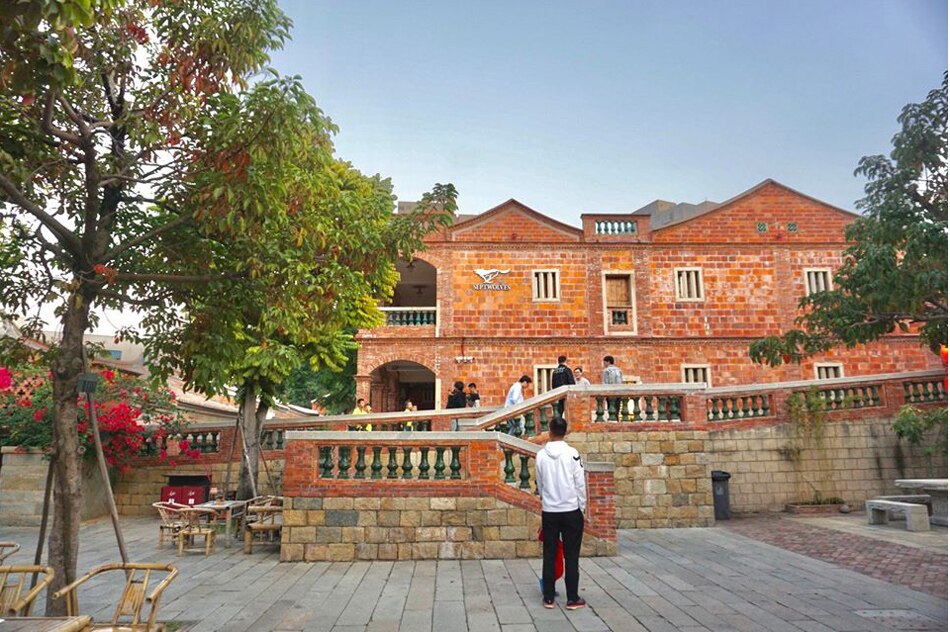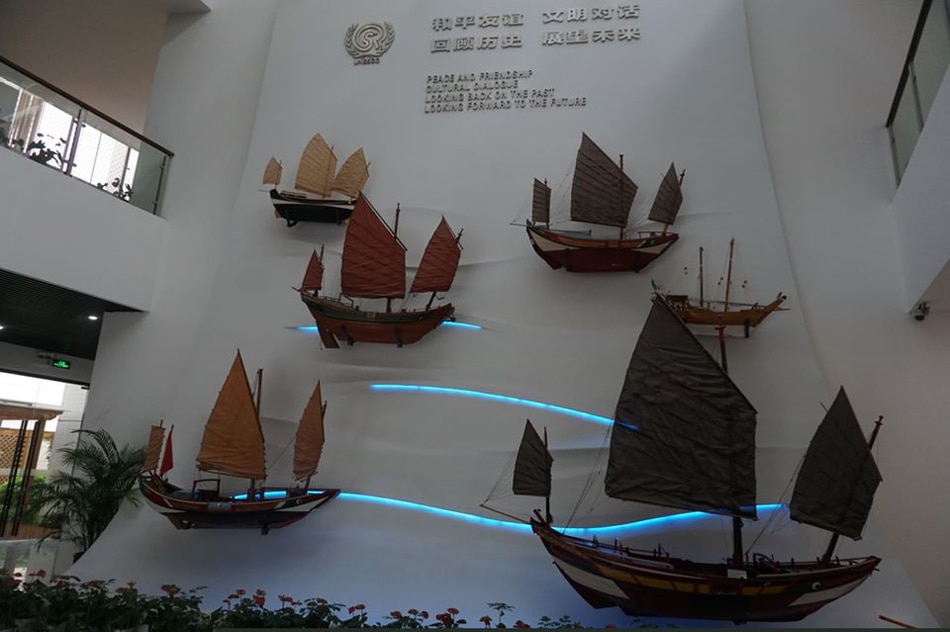China’s Fujian province eyes Davao tourists after Davao-Jinjiang City sisterhood pact | ABS-CBN
ADVERTISEMENT

Welcome, Kapamilya! We use cookies to improve your browsing experience. Continuing to use this site means you agree to our use of cookies. Tell me more!
China’s Fujian province eyes Davao tourists after Davao-Jinjiang City sisterhood pact
China’s Fujian province eyes Davao tourists after Davao-Jinjiang City sisterhood pact
Hernel Tocmo,
ABS-CBN News
Published Nov 12, 2019 08:28 PM PHT
FUJIAN, China -- Since the signing of sisterhood pact between Jinjiang and Davao City on November 15, 2018, tourist arrivals from China have significantly increased, especially with the launch of direct flights between the two cities in December 2018.
FUJIAN, China -- Since the signing of sisterhood pact between Jinjiang and Davao City on November 15, 2018, tourist arrivals from China have significantly increased, especially with the launch of direct flights between the two cities in December 2018.
Huang Mingyi, president of Jinjiang-based Fujian Your Tour International Travel Agency, said the number of customers going to Davao City, whether for business or leisure, grew 40 to 50 percent from last year.
Huang Mingyi, president of Jinjiang-based Fujian Your Tour International Travel Agency, said the number of customers going to Davao City, whether for business or leisure, grew 40 to 50 percent from last year.
However, he also admitted that there are more Chinese going to Davao compared to Davaoeños visiting Jinjiang. Thus, promotion events in Davao City are being planned to further introduce its sister city.
However, he also admitted that there are more Chinese going to Davao compared to Davaoeños visiting Jinjiang. Thus, promotion events in Davao City are being planned to further introduce its sister city.
Jinjiang City and the Fujian Provincial Government recently invited mediamen from Davao City for a familiarization tour to further promote the Chinese city to fellow Davaoeños.
Jinjiang City and the Fujian Provincial Government recently invited mediamen from Davao City for a familiarization tour to further promote the Chinese city to fellow Davaoeños.
ADVERTISEMENT
Despite the ongoing maritime dispute between Philippines and China, Jinjiang hopes to develop closer relations with Davao, officials said, citing the long trading history between the two countries.
Despite the ongoing maritime dispute between Philippines and China, Jinjiang hopes to develop closer relations with Davao, officials said, citing the long trading history between the two countries.
Luo Guansheng, the deputy director feneral of Fujian Foreign Affairs Ministry, said 80 percent of overseas Chinese in the Philippines come from their province. Among the Chinese-Filipino tycoons who were born in Fujian are Lucio Tan, John Gokongwei, and Henry Sy.
Luo Guansheng, the deputy director feneral of Fujian Foreign Affairs Ministry, said 80 percent of overseas Chinese in the Philippines come from their province. Among the Chinese-Filipino tycoons who were born in Fujian are Lucio Tan, John Gokongwei, and Henry Sy.
"Apart from Manila, Davao City has a large number of overseas Jinjiang people, who are doing business over there. They have this business alliance to push locally in their people level to push for a closer relationship between Davao and Jinjiang City," said Nathan Zhang, a staff from Fujian Provincial Foreign Affairs Office.
"Apart from Manila, Davao City has a large number of overseas Jinjiang people, who are doing business over there. They have this business alliance to push locally in their people level to push for a closer relationship between Davao and Jinjiang City," said Nathan Zhang, a staff from Fujian Provincial Foreign Affairs Office.
SPOTS TO VISIT IN JINJIANG, FUJIAN
Guansheng said over 13,000 Filipinos went to Fujian last year, while more than 10,000 have visited the province in the first nine months of 2019. Officials are positive that more Filipinos will visit the province, especially with the direct flights between Davao and Jinjiang.
Guansheng said over 13,000 Filipinos went to Fujian last year, while more than 10,000 have visited the province in the first nine months of 2019. Officials are positive that more Filipinos will visit the province, especially with the direct flights between Davao and Jinjiang.
Jinjiang's Jose Rizal Square is among the tourist destinations popular with Filipinos. One can find here the tallest Rizal monument outside the Philippines at 18.61 meters.
Jinjiang's Jose Rizal Square is among the tourist destinations popular with Filipinos. One can find here the tallest Rizal monument outside the Philippines at 18.61 meters.
In early 2000, the Jinjiang government, the Federation of Philippine Chinese Chamber of Commerce, and seven other organizations agreed to establish a Rizal Park in Jinjiang.
In early 2000, the Jinjiang government, the Federation of Philippine Chinese Chamber of Commerce, and seven other organizations agreed to establish a Rizal Park in Jinjiang.
Rizal was said to be a 22nd-generation descendant of the Ke family, who settled in Shang-Guo village in Jinjiang City.
Rizal was said to be a 22nd-generation descendant of the Ke family, who settled in Shang-Guo village in Jinjiang City.
Jinjiang has also preserved its former city center that now draws many tourists. The Wudianshi Traditional Block is located at the heart of the city amid high-rise buildings. It is comprised of 130 ancient houses and buildings, 70 percent of which are still original, although some have been transformed into restaurants, cafes, and souvenir shops.
Jinjiang has also preserved its former city center that now draws many tourists. The Wudianshi Traditional Block is located at the heart of the city amid high-rise buildings. It is comprised of 130 ancient houses and buildings, 70 percent of which are still original, although some have been transformed into restaurants, cafes, and souvenir shops.
Some of the historical homes were also converted into museums, such as the residence of a former Jinjiang official, as well as a luxurious house owned by a Chinese-Filipino over 100 years ago.
Some of the historical homes were also converted into museums, such as the residence of a former Jinjiang official, as well as a luxurious house owned by a Chinese-Filipino over 100 years ago.
For shoppers and those looking for souvenirs, Jinjiang City has several malls and shopping centers, including a familiar brand among Filipinos -- the SM City Jinjiang, which resembles SM malls in the Philippines, save for the Chinese signages and Chinese brands.
For shoppers and those looking for souvenirs, Jinjiang City has several malls and shopping centers, including a familiar brand among Filipinos -- the SM City Jinjiang, which resembles SM malls in the Philippines, save for the Chinese signages and Chinese brands.
In the neighboring Fuzhou City, a three-hour drive from Jinjiang, tourists can visit the Fuzhou Forest Trail. The Fuzhou government built in 2015 the Fudao or "trail of fortunes," a 19-kilometer elevated pedestrian walkway surrounded by bamboo, banyan and other trees. Tourists can also get a panoramic view of Fujian's capital city.
In the neighboring Fuzhou City, a three-hour drive from Jinjiang, tourists can visit the Fuzhou Forest Trail. The Fuzhou government built in 2015 the Fudao or "trail of fortunes," a 19-kilometer elevated pedestrian walkway surrounded by bamboo, banyan and other trees. Tourists can also get a panoramic view of Fujian's capital city.
At night, the Three Lane and Seven Alleys in Gulou District attract both locals and tourists. Here, one can find 150 ancient houses from the Ming and Qing Dynasty that have been preserved. Some of these houses have been converted into shops, restaurants, bars and milk tea stores, while retaining their original structure and architectural design.
At night, the Three Lane and Seven Alleys in Gulou District attract both locals and tourists. Here, one can find 150 ancient houses from the Ming and Qing Dynasty that have been preserved. Some of these houses have been converted into shops, restaurants, bars and milk tea stores, while retaining their original structure and architectural design.
If you are into Chinese culture and history, make sure to visit the Quanzhou Maritime Museum in Quanzhou City, which shows the starting point of the Maritime Silk Road, as Quanzhou was the center of overseas trade activities in ancient China. Cultural and religious relics, as well as shipwrecks and models of ancient vessels, were preserved given the great historical significance of Quanzhou Bay. Many Chinese also departed from here and sailed to the Philippines to trade with the Filipinos.
If you are into Chinese culture and history, make sure to visit the Quanzhou Maritime Museum in Quanzhou City, which shows the starting point of the Maritime Silk Road, as Quanzhou was the center of overseas trade activities in ancient China. Cultural and religious relics, as well as shipwrecks and models of ancient vessels, were preserved given the great historical significance of Quanzhou Bay. Many Chinese also departed from here and sailed to the Philippines to trade with the Filipinos.
While Fujian province may have highly developed cities, tourists may encounter some problems particularly in terms of language as only a few locals can understand English. In Jinjiang, there are also not too many taxis.
While Fujian province may have highly developed cities, tourists may encounter some problems particularly in terms of language as only a few locals can understand English. In Jinjiang, there are also not too many taxis.
"As you can see, security here is guaranteed because we are a very safe and secure country. And our government is also doing their best to improve the infrastructure. All nice cities in Fujian province is now connected by express train services. That's a great way to move around the province. And also we are encouraging people to learn other foreign languages. We would also like to see other foreign people to learn some Chinese when they come here," Zhang said.
"As you can see, security here is guaranteed because we are a very safe and secure country. And our government is also doing their best to improve the infrastructure. All nice cities in Fujian province is now connected by express train services. That's a great way to move around the province. And also we are encouraging people to learn other foreign languages. We would also like to see other foreign people to learn some Chinese when they come here," Zhang said.
Excluding airfare tickets, you can visit the 10 most popular tourist spots in Jinjiang, including national parks, ancient buildings and temples, as well as old Chinese villages, for 2,000 RMB or about P15,000 for four days.
Excluding airfare tickets, you can visit the 10 most popular tourist spots in Jinjiang, including national parks, ancient buildings and temples, as well as old Chinese villages, for 2,000 RMB or about P15,000 for four days.
ADVERTISEMENT
ADVERTISEMENT






